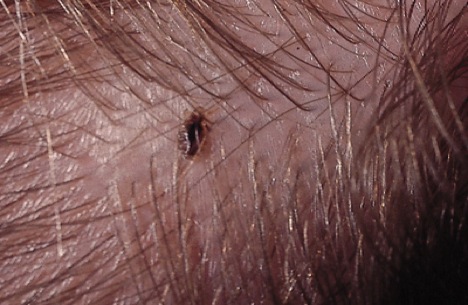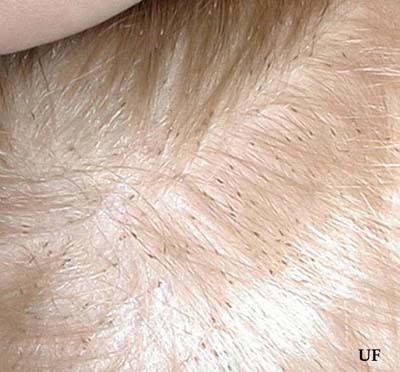Introduction to Head Lice
Head lice, latin name Pediculus humanus capitis, is a parasitic insect that is found in the hair, eyebrows, and eyelashes of humans.
Although some refer to head lice as scabies, this is a misnomer. Scabies is caused by a mite and not head lice.

Head lice feed on human blood for nutrients. If they do not receive blood, they will die in 2 to 3 days.
Head lice are around 3 millimeters in length and take on the color of blood when they begin feeding. Although the average life cycle of head lice is about a month, they cannot survive for long once they lose their source of food.
Once an louse loses it’s ability to feed, they will die in one or two days. Recent studies have also shown that head lice may be able to transmit diseases, such as certain types of fevers.
Symptoms of Head Lice
Usually, head lice are discovered by one of three ways. The first sign of head lice infestation is intense itching of the scalp. The itching is caused by a reaction to the saliva that a louse secretes. The other symptoms of head lice infestation are seeing lice or nits.
Head Lice? Get Remedies Fast!
Adult lice can be found on the human scalp while eggs, also called nits, are found attached to the hair shaft. If the “nit” comes off the hair shaft easily, then chances are it is not a louse egg. Lice eggs are attached firmly to the hair shaft and do not easily come off.
To search for head lice and their eggs, first wash and condition the hair of the person who may have lice. Since removing nits requires a fine-toothed comb, conditioning hair will make it easier to come. Make sure to use a good light and a fine toothed comb. Looking for adult lice along the hair line and individual nits attached to the hair shaft.
A magnifying glass can also be used to spot the tiny eggs. If the person is experiencing itching without the presence of lice or eggs, then chances are there is not an infestation.
Causes of Lice Infestation
Contrary to what some people think, human head lice cannot jump from one person to another. They are only mobile by walking. The spread of lice is also not caused by being unclean.
Head lice are spread through the shared use of personal items such as hear accessories (barrettes and headbands), combs, brushes, hats, or anything else that can come in contact with human hair. Lice can also be spread on pillows, blankets and towels. Upholstered furniture, including plush movie theater seats, can harbor head lice and their eggs.
Risks of Lice Infestation
As stated in the causes of infestation, hygiene is not a factor in lice infestation. Coming in contact and sharing hair related items with people who are infested cause the lice to spread. Young children who are in pre-school or elementary school, are more likely to contract head lice simply because they share their hair accessories more often.
Prevention of Head Lice
The best method for the prevention of head lice is to stop sharing items that are infesting. Since it is nearly impossible to control the sharing of all objects infected by lice, it is also important to completely rid areas of lice when they are numerous. That involves thorough cleaning of areas where lice or nits may be present.
Testing for and Diagnosing Head Lice Infestation
Usually, head lice can be found through a routine check at school or at home. Searching for nits and adults is the best way to diagnose the presence of head lice. If there seem to be nits on the hair shafts but there appear to be no adults, try and remove the nit with a very fine toothed comb.
If any question remains or the person who suspects a head lice infestation is unsure, a doctor can diagnose the presence of lice. When there is an outbreak at school, church, or anywhere else large groups may gather, then it may be a good idea to check for head lice, even if an infestation is not suspected.
Treatment of Head Lice

There are several ways to treat head lice infestation. What is most important to remember is that the lice and eggs could have been transferred to pillow, towels, hats, or anything else plush or upholstered that came in contact with a person who has head lice. There are treatments that are chemical, organic, prescription and over the counter.
Some of the treatments are:
Lindane (also under the names Kwell and Thionex) – this type of chemical kills lice and their eggs. It is only available with a prescription and is used as a second resort if other treatments have failed.
In recent years, there has been controversy over the use of lindane as it is an insecticide that is easily absorbed into the skin. Lindane is a topical crème, lotion or shampoo. If it is left on the scalp or other areas too long, it will be absorbed and can cause seizure disorders.
It is not recommended for infants, toddlers, people with sores or open wounds, people weighing under 110 pounds or those with seizure disorders. Kwell has been reportedly linked to a young man who was found to suffer from cancer. The pesticide in this product allegedly killed a school aged child who was prescribed Kwell twice in order to kill lice and eggs during an infestation.
Other Options Are:
Malathion lotion (Ovide) – this treatment is also available only by prescription. It kills adult lice and some eggs, although a second treatment to kill newly hatched lice is needed to kill any lice that have hatched since the first treatment.
Pyrethrins (sold as A-200, Pronto, R&C, Rid and Triple X) – this type of remedy is available over the counter. However, this remedy only kills adult lice and another treatment will have to be used once the nits have hatched, which is approximately 8 to 10 days after the first treatment. These types of treatments run anywhere from $7 to $20 per bottle, which is $14 to $40 per family member, since anyone who may have come in contact with the person may be infected and there needs to be 2 treatments. Similar to other treatments, lice may be resistant.
Permethrin (sold as Nix) – this is a synthetic form of the pyrethrins. It is also sold over the counter and only kills adult lice. This type of treatment may also continue to kill young lice for a couple of days after the initial treatment, but a second treatment is recommended 8 to 10 days after the first treatment. Lice may also be resistant to this type of treatment. This treatment can be less expensive than the pyrethrins; 2 bottles, or 2 treatments, are approximately $20.
Tea Tree Oil – this type of oil can be found in health food stores as well as nationwide retailers. Although this treatment is considered natural, there are warnings that it is not safe for pregnant women, babies, young children and pets. Tea Tree Oil can irritate skin and cause a reaction. In high doses, it causes liver toxicity. There is no indication whether or not this treatment works. The cost of tea tree oil is $7 and up. Cost will depend on the purity and amount of the oil.
Mayonnaise – some people use this remedy to remove nits. In theory, the oil in mayonnaise will make the nits slip off the hair shaft and will suffocate the lice. Mayonnaise is under $10 for an abundance of treatment. There is no indication whether or not this treatment works.
Vaseline – similar to mayonnaise, this treatment is meant to suffocate and slide lice and their eggs form the hair and scalp. Vaseline cost a couple of dollars, but there is no indication that this treatment works.
LiceMeister Comb – this type of treatment uses no chemicals. It uses the concept of manual removal of lice and nits. This comb also comes with a card to help identify nits and lice. The comb costs around $10. Since there are no chemicals used in this type of treatment, there is no risk of lice becoming resistant to a LiceMeister Comb. This comb can also be used as a preventative medicine as it can be used to check for the presence of lice and eggs on a regular basis. There are cleaning kits and replacement parts also available.
Wrapping the head – while some people suggest wrapping the head in plastic, it does not remove the source of food from the lice and is therefore ineffective. It is also dangerous to younger children to wrap plastic around their head as it may slip and cause suffocation. Plastic wrap is a couple of dollars.
All of the treatments listed above are remedies for lice and nits that are on humans. However, in order to totally remove the infestation, household items that could be carrying lice and nits need to be treated as well. It is recommended that clothing, hats, or any other items that are washable be washed in hot water and dried on the highest heat setting in a dryer.
Steps in Getting Rid of Lice
Water will not drown lice, but the extreme heat of water in the washer will kills them. Combs, brushes, and hair accessories should either be replaced or soaked in very hot water for at least 5 minutes. If there are clothing or other items that cannot be washed, they should be placed in plastic bags for a minimum of 3 days. This amount of time will kill lice and newly hatched eggs as they will be lacking nutrition to stay alive.
A thorough vacuuming of any upholstered or cloth furniture should also be done. This includes cloth headrests in cars. Spraying an insecticide or fumigant is not recommended as it can expose young children and pets to the toxic fumes. Make sure to notify schools, child cares and churches about the lice infestation so that they also can take precautions and preventative measures.
If after using an over the counter treatment twice does not kill any or some of the lice, the lice may be resistant to the treatment or the treatment may not have been used properly. It is only recommended that any one treatment be used a maximum of 2 to 3 times. If after treatments are used there are still live young or adult lice, a doctor should be consulted. Some oils used as natural treatments can also cause greater rates of absorption for the chemical treatments. It is suggested that oil and chemical treatments not be used in combination.

1 Comment
help this is the 4th time ive had lice in 3 months there little black dots on my scalp needed help ASAP